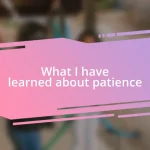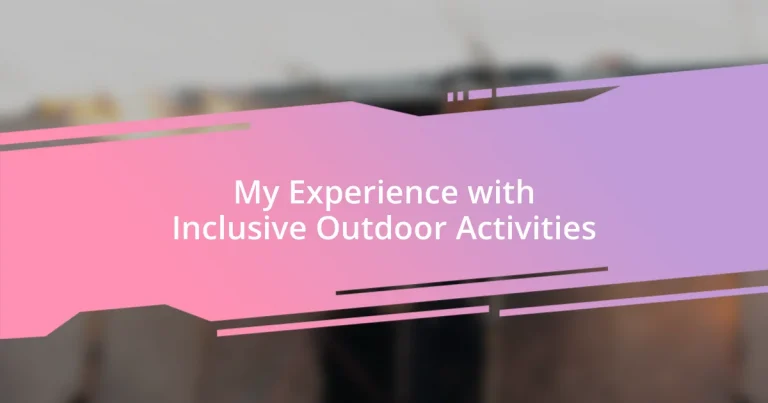Key takeaways:
- Inclusive outdoor activities foster connections and build community, allowing individuals of all abilities to share experiences and celebrate resilience together.
- Effective planning for inclusivity requires understanding participants’ needs, actively involving them, and ensuring accessibility to enhance everyone’s experience.
- Engaging diverse groups through shared activities and storytelling creates a sense of belonging, exemplifying how nature can bridge gaps between individuals from different backgrounds.
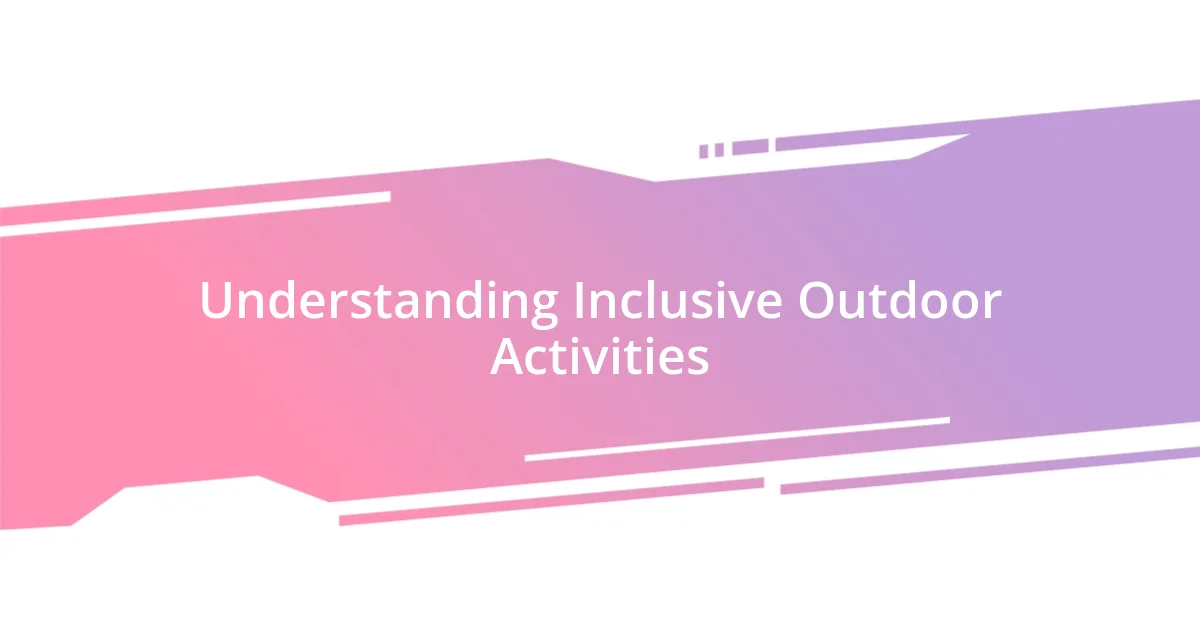
Understanding Inclusive Outdoor Activities
Inclusive outdoor activities encompass experiences designed to be accessible and enjoyable for everyone, regardless of their abilities. I still remember the first time I participated in an adaptive kayaking session; it was eye-opening. I found myself surrounded by a diverse group of individuals who shared a passion for adventure, and it was incredible to see how everyone came together in such a vibrant and supportive atmosphere.
One thing that struck me was how these activities break down barriers. Have you ever considered how empowering it feels to engage with nature alongside people who face different challenges? During a group hike, I witnessed a participant in a wheelchair navigate a scenic trail with specially designed equipment. It was not just about the trail; it was a collective celebration of resilience and determination that opened my eyes to the power of inclusivity in outdoor experiences.
The emotional richness of inclusive outdoor activities isn’t just about participation; it’s about fostering connections and friendships. I recall bonding with fellow adventurers around a campfire, sharing stories and laughter that transcended our differences. Isn’t it amazing how nature can create a sense of belonging, regardless of our individual stories? This sense of community amplifies the joy of exploring the great outdoors together, enriching our lives in ways we may never have anticipated.
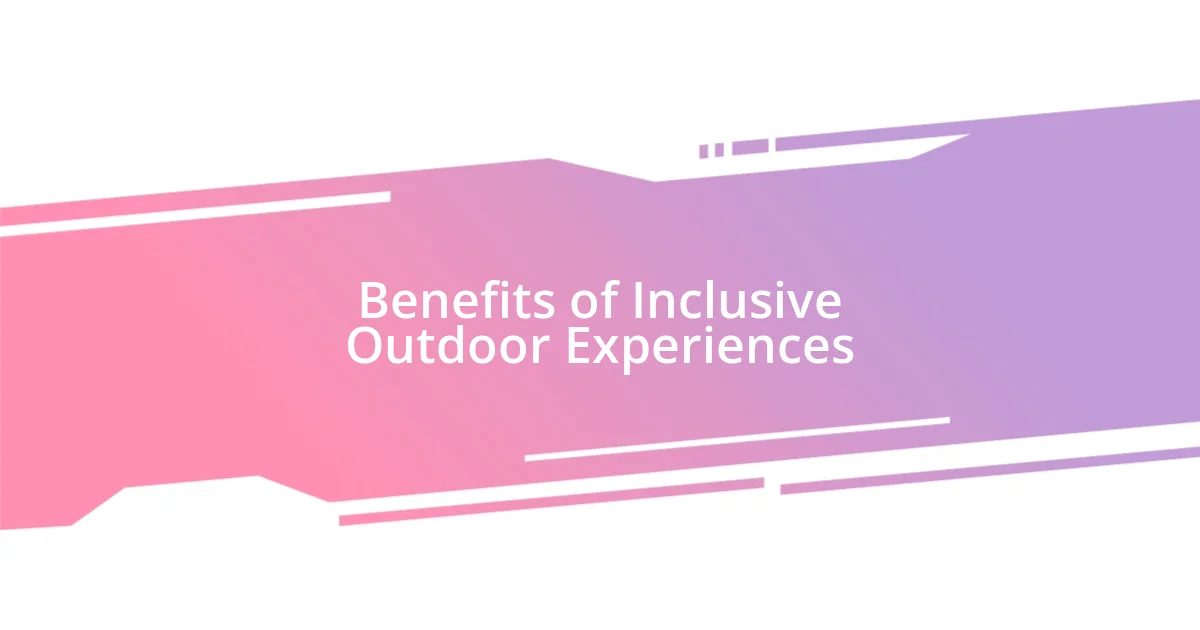
Benefits of Inclusive Outdoor Experiences
Participating in inclusive outdoor activities has profoundly impacted my perception of nature and community. I vividly recall a day spent rock climbing with a diverse team. As I watched a friend with a visual impairment ascend the wall using tactile cues and verbal encouragement, I was struck by how our collective energy transformed a simple climb into a powerful testament to our strengths. That day, I learned that inclusion not only enhances access but also amplifies the experience for everyone involved.
Here are some benefits of inclusive outdoor experiences:
- Community Building: They foster authentic connections among participants, creating friendships that extend beyond the activity itself.
- Empowerment: Individuals experience a sense of achievement that can boost self-esteem and confidence, regardless of their physical abilities.
- Diverse Perspectives: Engaging with a variety of backgrounds encourages empathy and broadens individual viewpoints on challenges and resilience.
- Shared Learning: Everyone brings unique skills and insights, enriching the group’s overall experience and learning opportunities.
- Mental Health Benefits: Nature has a calming effect that promotes well-being, making these activities therapeutic for all participants.
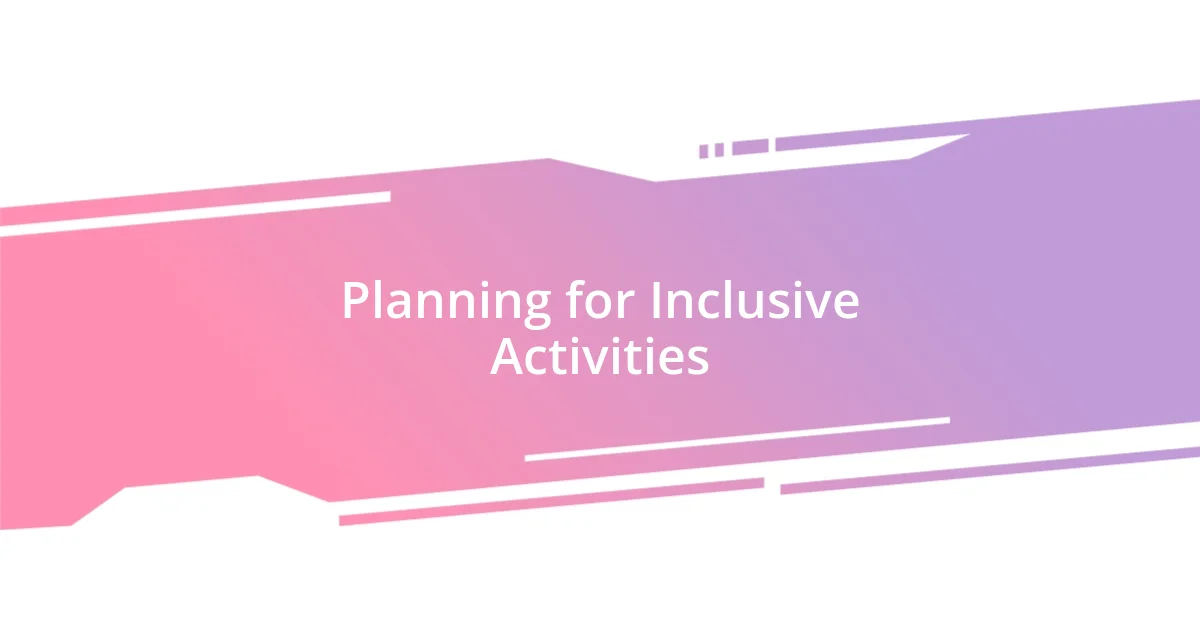
Planning for Inclusive Activities
When I think about planning inclusive activities, I realize that the foundation must start with understanding the specific needs and preferences of all participants. For instance, during a recent adaptive cycling event, we conducted a survey beforehand to gauge what modifications were necessary for comfort and safety. This simple step made a world of difference; the event turned out to be a joyous celebration rather than a logistical challenge. Have you ever thought about how a little preparation can enhance the experience for everyone involved?
It’s also crucial to involve everyone in the planning process. I once joined a planning committee for an inclusive nature walk, and we had participants from various backgrounds contribute ideas. The insights shared were invaluable and led to the creation of an itinerary that was exciting and engaging for everyone. In one instance, we included sensory stations along the trail to enhance the experience for those with sensory processing differences. Isn’t it incredible how diverse input can enrich an activity?
Lastly, accessibility is paramount. During another memorable experience, I volunteered at a weekend outdoor festival, where we ensured pathways were wide and flat for those with mobility aids. It made me realize that small adjustments—like choosing the right location with proper facilities—truly empower everyone to participate fully. Everyone deserves the chance to enjoy nature, and seeing the smiles on participants’ faces when they navigated the event with ease was truly heartwarming.
| Aspect | Traditional Planning | Inclusive Planning |
|---|---|---|
| Participant Input | Minimal feedback | Active involvement of all participants |
| Accessibility Features | Basic provisions | Tailored solutions for individual needs |
| Emotional Engagement | Focus on logistics | Fostering connection and community |
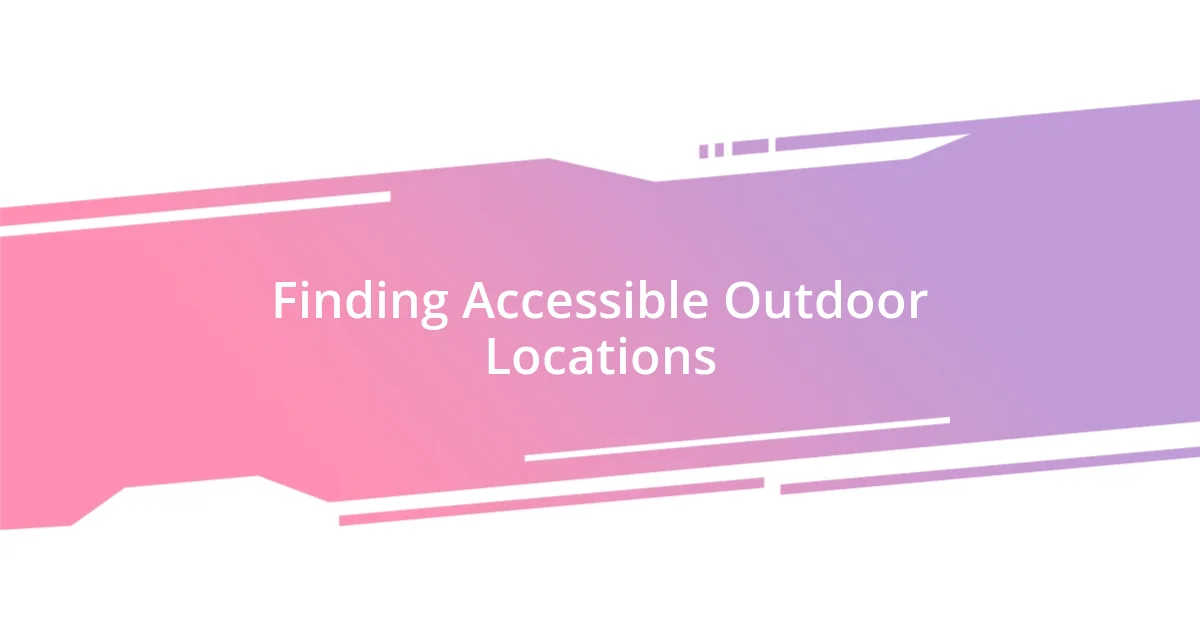
Finding Accessible Outdoor Locations
Finding accessible outdoor locations can genuinely transform one’s experience in nature. I’ve had moments where the search for the perfect spot felt like a treasure hunt. Once, I spent an exhilarating afternoon hiking with friends at a scenic park that was fully equipped with paved trails. It was so rewarding to see everyone enjoying the beauty of nature, regardless of mobility challenges. Have you ever found a hidden gem that made you appreciate the outdoors even more?
In my experience, it’s vital to research locations ahead of time. I recall planning a camping trip and discovered a site with accessible fire pits and restrooms—little details that created a welcoming atmosphere for our group. While browsing online reviews, I analyzed comments about specific features, which gave me a sense of what to expect. This made me realize that not all locations might meet everyone’s needs, so it’s essential to dig deeper. How often do we overlook seemingly mundane aspects, thinking they can’t impact our enjoyment?
Moreover, technology plays a big role in finding accessible locations today. I remember discovering an app that lists parks with adaptive features right when I was looking for a place to paddleboard. That tool saved us time and allowed us to focus on having fun rather than worrying. The excitement on my friends’ faces as we glided across the water, knowing we found a space that welcomed us all, was priceless. Have you explored the apps or websites that cater specifically to accessibility needs?
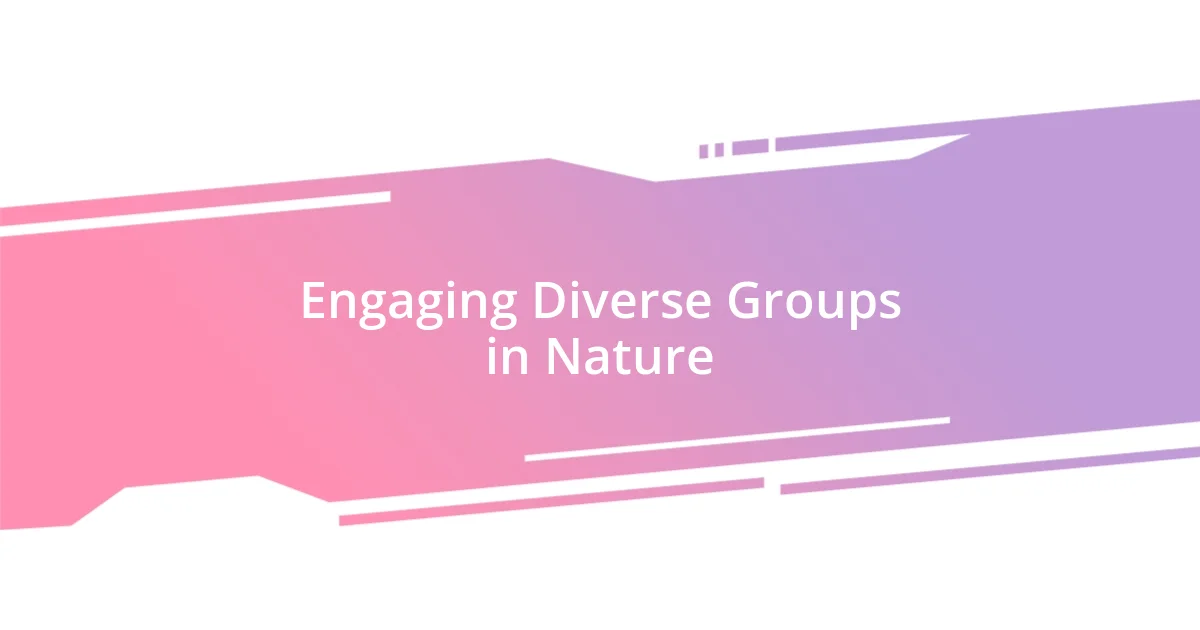
Engaging Diverse Groups in Nature
When it comes to engaging diverse groups in nature, I’ve come to understand the power of shared experiences. I remember leading a team-building exercise with co-workers from various cultural backgrounds during a weekend retreat. Each person brought a unique perspective to our outdoor exploration, sparking discussions that went beyond the trails. Have you noticed how the beauty of nature can bring people together in unexpected ways?
One memorable experience was organizing a community event where we introduced yoga in the park. Participants from different age groups and abilities joined in, and it was heartwarming to see a grandmother practicing alongside her grandkid. This shared space fostered connection and left everyone feeling more included. It made me realize that when we create environments where diverse groups can thrive, we cultivate a sense of belonging. Isn’t it amazing how a simple activity can bridge generational gaps?
Moreover, I believe storytelling is a vital tool for engagement. During an outdoor gathering, I encouraged everyone to share their favorite nature moments. As stories unfolded, so did laughter and camaraderie. Those tales resonated with everyone, creating a lively tapestry that binded us together. Have you ever witnessed the magic of storytelling in bringing people closer like that? From my own experience, I can say that it enhances a group’s appreciation for their surroundings while highlighting the diverse connections we all share to nature.
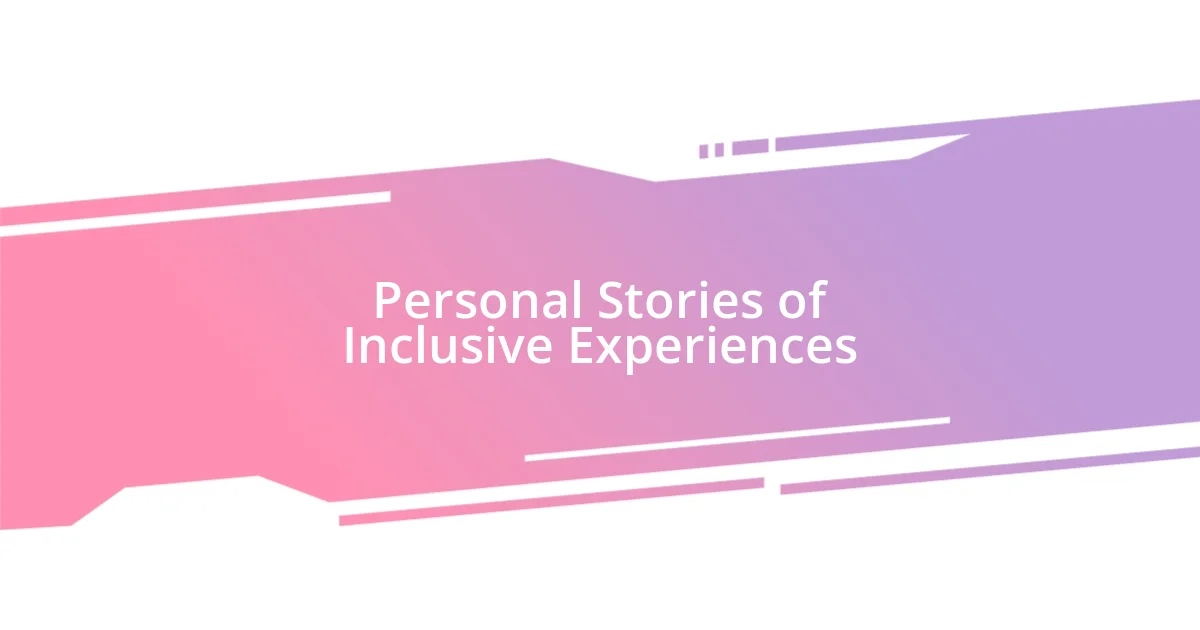
Personal Stories of Inclusive Experiences
One of my most impactful inclusive experiences happened during a beach cleanup. I volunteered alongside individuals with various abilities, and we all worked together toward a common goal. The joy that filled the air was palpable, especially when we stumbled upon a quiet cove packed with colorful shells. I could see the expressions of delight on everyone’s faces. It made me wonder, how often do we overlook simple joys when we’re focused on a task?
Another memorable moment was at a community gardening event where we encouraged participation from people of all ages and backgrounds. I’ll never forget the pride on a young child’s face when she planted her first seedling alongside an elderly neighbor. It was more than just planting; it was about building relationships and sharing knowledge. Have you ever witnessed a simple act creating such a strong bond? In that moment, I realized that nature can be a nurturing ground not only for plants but also for friendships.
I also cherish the times I joined adaptive sports groups for kayaking. The excitement was contagious as we navigated the water together, regardless of our different abilities. One day, I remember a participant who was initially apprehensive about joining us. By the end of the session, she was laughing and splashing water around, fully immersed in the experience. Isn’t it incredible how nature has a way of breaking down barriers and fostering a sense of adventure? Moments like these resonate deeply with me, illustrating that inclusivity transforms not just activities but the lives we touch.
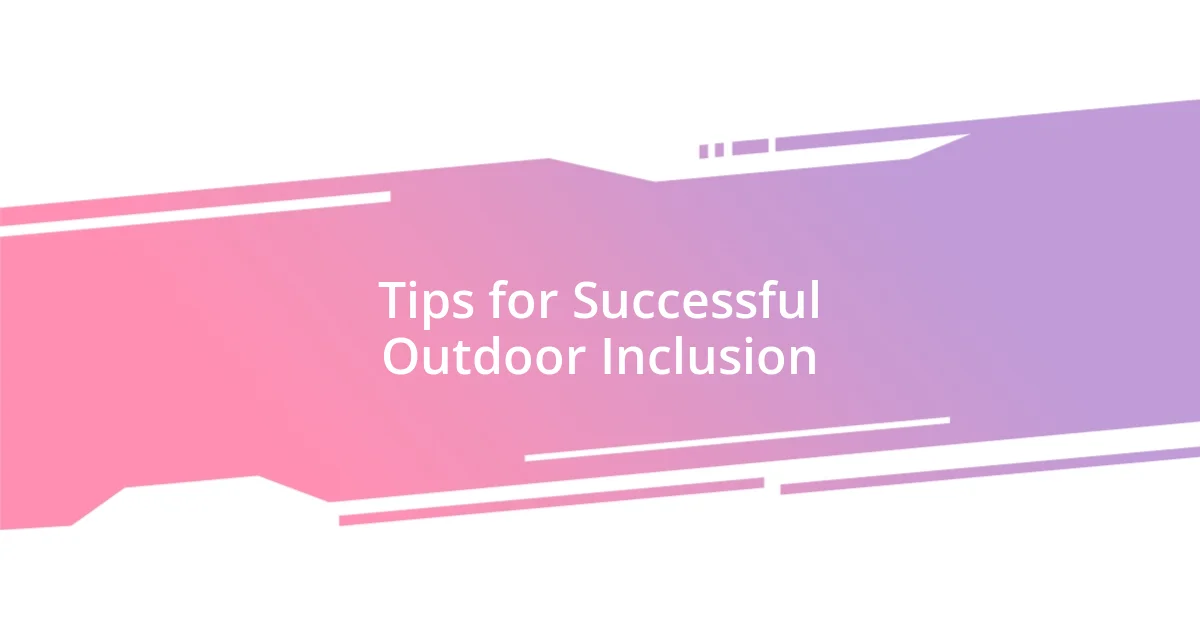
Tips for Successful Outdoor Inclusion
To create successful outdoor inclusion, it’s essential to prioritize accessibility. I once organized a hike where we ensured that everyone could participate, regardless of their mobility. We mapped accessible trails and arranged for shuttle services, which really made a difference. Have you seen how small adjustments can open up opportunities for many? It’s enlightening to witness community members learn and enjoy together.
Another tip is to encourage co-creation of activities. During a family camping trip, I suggested that everyone pitches in ideas for our evening campfire stories. It turned into an event filled with laughter, as diverse tales from different cultures emerged. The children were especially engaged, which made me realize how actively involving participants fosters a stronger sense of belonging. Don’t you think that when people contribute, they naturally feel more connected?
Lastly, fostering a culture of openness is key. I remember a picnic where participants were invited to share their outdoor interests. One participant spoke about her love for birdwatching, which sparked a spontaneous bird-identification challenge among everyone present. The energy was electric, and I could see connections forming right before my eyes. Can there be anything more fulfilling than nurturing a space where everyone feels free to share their passions? It’s moments like these that highlight how inclusive practices can thrive when we let our guards down.








